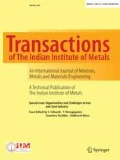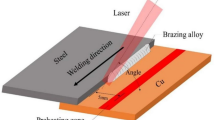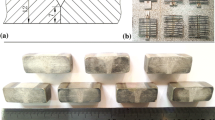Abstract
In this paper, the lap joint of H62 copper alloy was carried out by pulsed laser welding. The effects of different powder interlayers on the microstructure, shear properties and corrosion properties of H62 copper alloy lap joints were studied. The results show that the welding joints with proper powder interlayer have achieved good welding forming. There are no defects such as pore and crack in the welding joints. The welding joints are fully penetrated with different powder interlayers except Ni powder interlayer. The grain size of weld is smaller than that of base metal. The maximum polar density of base metal is 6.46 in (001) [0–10] cubic texture, and there are two weaker (112) [111] Cu textures and (111) [1–21] textures. The maximum polar density of the weld is 5.39. The maximum position deflects, and (001) [0–10] cubic texture disappears. The weld is confused compared with the base metal, and the grain distribution is basically of random orientation. The addition of Zn powder reduces the welding stress. The shear strength of welding joints with Zn powder interlayer is the best, 82.27 MPa, which is 18% higher than that of welding joints without powder. The corrosion resistance of welding joints with different powder interlayers is as follows: no addition > Ni Powder > Zn Powder > Sn powder.













Similar content being viewed by others
References
Zhang L J, Bai Q L, Ning J, Wang A, Yang J N, Yin X Q and Zhang J X, Mater Des 110 (2016) 35.
Miyagi M and Zhang X D, J Laser Appl 27 (2015) 042005.
Yilling Q, Wang G X, Lu L, Wang Z, Xu H, Liu S and Wang D, Electrochim Acta 29 (2020) 136606.
Zhang Y, Li Y, Luo Z, Yuan T, Bi J, Wang Z M, Wang Z P and Chao Y J, Mater Des 106 (2016) 235.
Avettand-Fènoël M N, Racineux G, Debeugny L and Taillard R, Mater Des 98 (2016) 305.
Zhang G F, Zhang L J, Kang C W and Zhang J X, Mater Des 94 (2016) 502.
Zhang G F, Takahashi Y, Heng Z H, Takashima K and Misawa K, Mater Trans 56 (2015) 1842.
Schmidt H C, Ebbert C, Rodman D, Homberg W, Grundmeier G and Maier H J, Key Eng Mater 651–653 (2015) 1421.
Megahed G M, El-Koumy M M, Fathy A, Mahallawi I E and El-Anwar M, Steel Res Int 90 (2019) 1900208.
Sommer M, Weberpals J P, Muller S, Berger P and Graf T, J Laser Appl 29 (2017) 012001.
Shi W Q, Yang Y Q, Wang D, Huang D L and Meran C, Trans China Weld Inst 31 (2010) 101.
Wang D, Yang Y Q and Shi W Q, Appl Laser 29 (2009) 203.
Hao K D, Gong M C, Xie Y, Gao M and Zeng X Y, Opt Laser Technol 102 (2018) 124.
Florian H, Konstantin H, Stefan S and Michael S, Phys Procedia 56 (2014) 576.
Li Y, Hu S S, Shen J Q and Liu L L, Int J Adv Manuf Technol 79 (2018) 627.
Anbukkarasi R and Kailas S V, Trans Indian Inst Metals 72 (2019) 1603.
Rasaee S, Mirzaei A H, Almasi D and Hayati S, Trans Indian Inst Metals 71 (2018) 1553.
Mostaan L S, Seyyed E M and Ali S, Trans Indian Inst Metals 70 (2017) 1869.
Zhu J, Xu L, Lu M, Zhang L, Chang W and Hu L, Corros Sci 93 (2015) 336.
Acknowledgements
This research was financially supported by the National Natural Science Foundation of China (Grant No. 51505040), Jiangsu Key Laboratory of Large Engineering Equipment Detection and Control under Grant No. JSKLEDC201507. This project was also supported by postdoctoral research funding plan in Jiangsu Province under Grant No.2018K055C.
Author information
Authors and Affiliations
Corresponding author
Additional information
Publisher's Note
Springer Nature remains neutral with regard to jurisdictional claims in published maps and institutional affiliations.
Rights and permissions
About this article
Cite this article
Yu, B., Dai, J., Yang, L. et al. Effect of Powder Interlayer on Copper Alloy Lap Joint by Laser Welding. Trans Indian Inst Met 73, 2577–2585 (2020). https://doi.org/10.1007/s12666-020-02064-x
Received:
Accepted:
Published:
Issue Date:
DOI: https://doi.org/10.1007/s12666-020-02064-x




